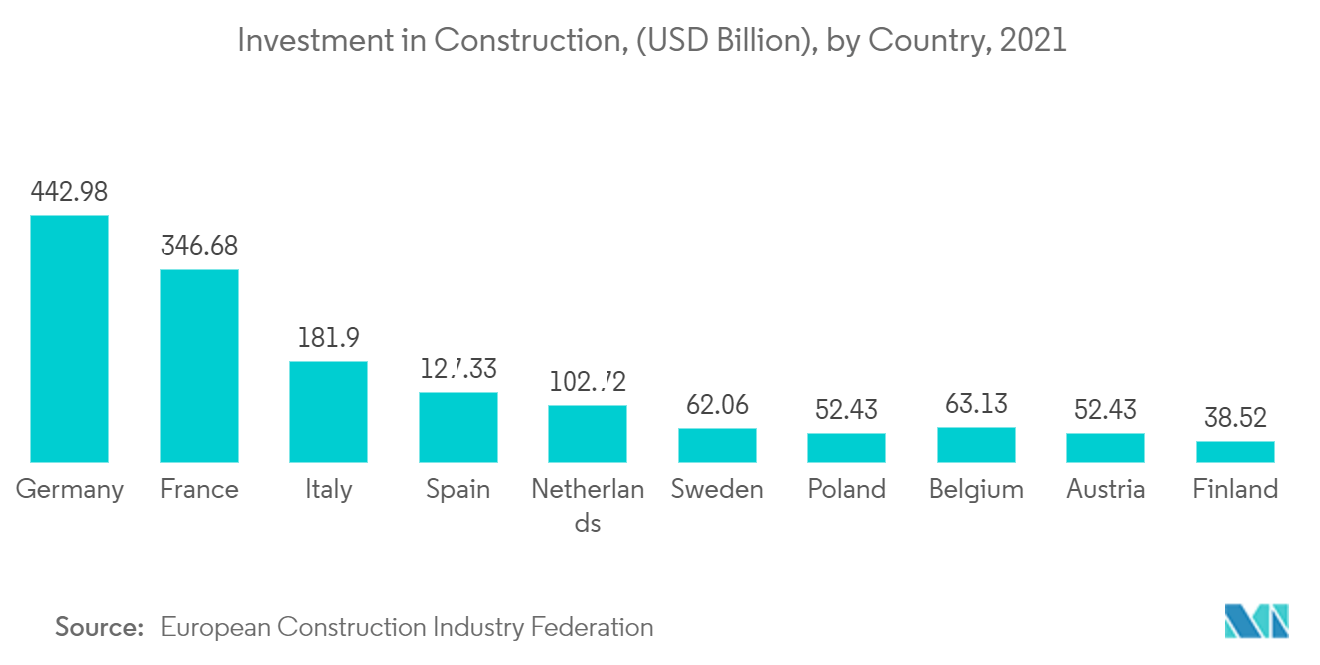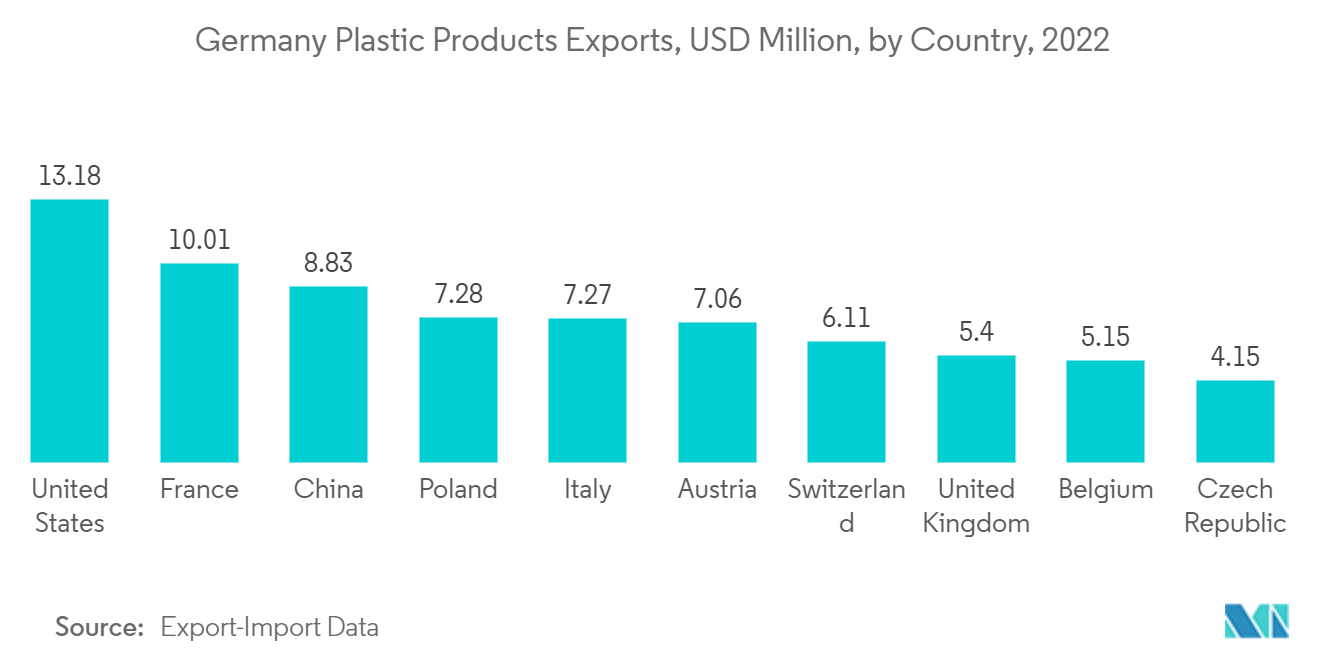Market Trends of Europe Polycarbonate Sheets Industry
Increasing Demand from the Construction Industry
Construction is the major end-user industry for the polycarbonate sheets market, accounting for more than 65%. Polycarbonate sheets are used in roofing, cladding, and glazing applications in the construction industry owing to their lightweight, easy installation, and energy-conservation features. They are used in fences and walls in residential and commercial building projects.
Polycarbonate is a high-performing thermoplastic widely used in building and construction products, from windows and skylights to wall panels and roof domes to exterior elements for LED lighting. In 2021, European thermoplastic production totaled 57.2 million metric tons, an increase of six percent from the previous year.
According to the European Bioplastics, in cooperation with the nova-Institute, global bioplastics production capacities are set to increase from around 2.23 million tonnes in 2022 to approximately 6.3 million tonnes in 2027.
Polycarbonate roofs are the current trend in buildings, walkways, and other roofing because of their UV protection feature. This is the result of UV stabilizers in polycarbonate to help protect the material from the sun and sustain it for longer.
In Europe, Germany is the leading construction market and home to the continent's largest building stock. The construction sector is booming in Germany. The growing population, demographic changes, and favorable economic environment drive the country's high demand for residential buildings. Residential sector demand can be found in multigenerational houses, micro-apartments, and prefabricated buildings.
In the United Kingdom, the construction sector contributes to around 6% of the country's GDP. To provide better infrastructure to the population across the country, the government has planned to invest 1-2% of its GDP in infrastructure by 2050 as part of the National Productivity Investment Fund (NPIF).
In Spain, the demand for new housing units is rising, supported by better employment conditions. Spain's National Statistics Institute (INE) estimates that the net household creation in 2019-2025 will be an average of 135,000 units yearly.
Under NPIF, the European government is planning to invest USD 27.68 billion in housing, science and innovation, transport, and a 5G network over the next five years, of which around USD 8.67 billion is allocated for the construction of new homes and USD 4.8 billion is allocated to infrastructures such as roads bridges, pavements, and others.
Various construction companies are investing in projects that help boost the demand for polycarbonate polymer materials. For instance, in 2021, Saint-Gobain acquired RABONI Normandie, a multi-specialist distributor of construction materials in France's dynamic residential renovation and energy efficiency market, and started working on various construction projects in the country.
Polycarbonate is ideal for protecting wireless technology because it allows wireless and radio frequency signals to pass unobstructed through the enclosure. According to the German Electrical and Electronic Manufacturers Association (ZVEI), in 2022, the total Europe production of the electric and digital industry reached USD 640 billion, a 13% increase in value compared to the same period last year.
The European market for polycarbonate sheets is projected to witness exponential growth, majorly owing to the Renovation Wave Initiative launched by the European Commission to renovate European buildings and make Europe carbon neutral by 2050.
Additionally, when compared to glass, a solid polycarbonate sheet has a far higher impact. This is extremely useful for any project's transportation, handling, and installation phases. Moreover, polycarbonate sheets provide higher resistivity against hail, falling branches, and other objects when compared to the resistivity of glass, acrylic, or GRP/fiberglass. Also, unlike GRP, polycarbonate does not become more brittle with age.
Polycarbonate sheets can also be laminated with a polyurethane film adhesive under heat and pressure for more demanding applications where resistance to forced entry is needed. It can also be laminated with glass layers on the outer skin to provide even better chemical resistivity. Glass-clad polycarbonate laminates offer resistivity to high-powered ballistics.
The factors above are expected to drive the consumption of polycarbonate sheets in the construction industry during the forecast period.

Germany to Dominate the Market
The German economy is the largest in Europe and the fifth-largest globally. In 2022, Germany's GDP increased by 1.8% due to a boost in demand that followed the post-pandemic reopening of the economy.
In 2021, the German government constructed around 1.5 million housing units that, boosted the consumption of polycarbonate sheets. The overhang of pending residential building permits increased to more than 400,000, suggesting the sector's growth.
According to the Federal Statistical Office (Destatis), Germany had a minimum of 84.3 million inhabitants at the end of 2022, an increase of 1.1 million compared with the end of 2021.
The increasing migration to the country has stimulated the demand for new residential construction. About 3.6 million migrants arrived in Germany by the end of 2020-2021, which required at least 350,000 new dwellings per year.
According to the German Electrical and Electronic Manufacturers Association (ZVEI), in 2022, the total Europe production of the electric and digital industry reached USD 640 billion, a 13% increase in value compared to the same period last year.
Several investment projects and product development by the companies help the market for polycarbonate sheets to grow. For instance, in 2021, Covestro AG, a German polycarbonate-based producer, presented innovative polycarbonate solutions for various industries, including construction, automobile healthcare, and electronic appliances.
All the abovementioned factors are expected to provide growth opportunities for the polycarbonate sheets industry over the forecast period.


